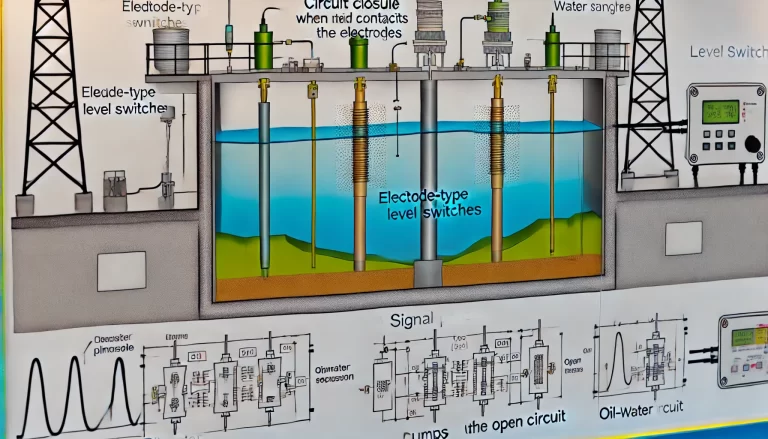Introduction
Electrode-type level switches operate based on the electrical conductivity of liquids. These switches leverage the liquid’s ability to act as a conductive medium between electrodes, forming a closed electrical circuit when the liquid comes into contact with them. Typically, these switches consist of two or more electrodes installed at specified levels within a container. This article provides an in-depth exploration of their working principles, features, applications, and important considerations for their usage.
1. Working Principle
1.1 Electrode Installation
Electrodes are vertically installed inside the tank or container at predetermined positions corresponding to specific liquid levels. The electrodes are typically made of corrosion-resistant and wear-resistant materials, such as stainless steel, to ensure long-term reliable operation.
1.2 Circuit Operation
- Circuit Closure: When the liquid level rises and makes contact with one of the electrodes, the circuit is closed. The liquid acts as a conductive path for current to flow between the electrodes (or to a ground electrode).
- Circuit Interruption: Conversely, when the liquid level drops below the electrode, the circuit opens, interrupting the current flow.
1.3 Signal Processing
The level switch uses a signal processing circuit to convert the current flow signal into actionable outputs such as:
- Switch signals for turning equipment (e.g., pumps, valves) on or off.
- Analog signals for integration into monitoring and control systems.
These outputs can then trigger alarms, indicate the liquid level status, or automate operational processes.

2. Key Features
2.1 High Precision and Quick Response
Electrode-type level switches provide precise monitoring and instantaneous detection of liquid contact with electrodes. The advanced design of electrodes and processing circuits ensures minimal delays in response.
2.2 Durability and Versatility
- Electrodes are robust and can be custom-sized for various container shapes and monitoring requirements.
- Corrosion-resistant materials, such as stainless steel, extend service life and reliability in harsh environments.
2.3 Multi-Point Monitoring
These switches can accommodate multiple electrodes to monitor different liquid levels within the same container, allowing for comprehensive level management. Advanced models may also include indicators and alarm systems for visual and audible alerts.
2.4 Broad Applicability
Electrode-type level switches are suitable for any conductive liquid, excluding volatile liquids. They are widely used in industrial and domestic settings, such as chemical solutions, water tanks, and wastewater systems.
2.5 Anti-Fouling Design
Specially designed electrodes prevent material buildup, enhancing the switch’s reliability and stability, even in challenging environments like wastewater systems.
2.6 Long Service Life
Low-voltage electrodes minimize electrolytic effects, reducing corrosion and wear to ensure prolonged operational life.
2.7 Strong Anti-Interference Capability
The advanced signal processing circuit design ensures stable performance, even in environments with high electrical noise or electromagnetic interference.
3. Applications
3.1 Water Tank Level Control
Electrode-type level switches are ideal for managing liquid levels in water tanks, such as:
- Domestic water tanks: To automate water filling or draining.
- Firewater tanks: To monitor and ensure adequate emergency water levels.
3.2 Sewage Treatment Systems
In wastewater treatment plants, these switches play a vital role in managing liquid levels in sewage tanks. By detecting specific levels, they ensure timely drainage to prevent overflow or environmental contamination.
3.3 Oil-Water Separation
Electrode-type level switches are effective in oil-water separation systems. By using separate electrodes for oil and water layers, the switches can detect and control the interface levels, enabling precise separation processes.
3.4 Non-Corrosive Liquids
Applications extend to managing levels in pure water systems, cooling systems, and other non-corrosive liquids where stable and reliable performance is critical.

4. Key Considerations
4.1 Liquid Conductivity
Ensure that the liquid’s conductivity meets the minimum requirements for the electrode-type level switch. Non-conductive liquids, such as gasoline or heavy oils, require additional measures (e.g., adding conductive agents).
4.2 Installation Precision
- Position the electrodes carefully to align with desired monitoring levels.
- Install the electrodes at appropriate angles to ensure proper detection and avoid false readings.
4.3 Regular Maintenance
- Inspect electrodes regularly for wear or corrosion and replace damaged electrodes promptly.
- Clean electrodes periodically to prevent buildup, especially in wastewater or heavily polluted liquids.
Conclusion
Electrode-type level switches are highly versatile and reliable devices with extensive applications in industrial automation and liquid level management. Understanding their working principles, advantages, and usage considerations can help in selecting the right model and achieving optimal performance. These switches are indispensable tools for industries where accurate and responsive liquid level control is crucial.
